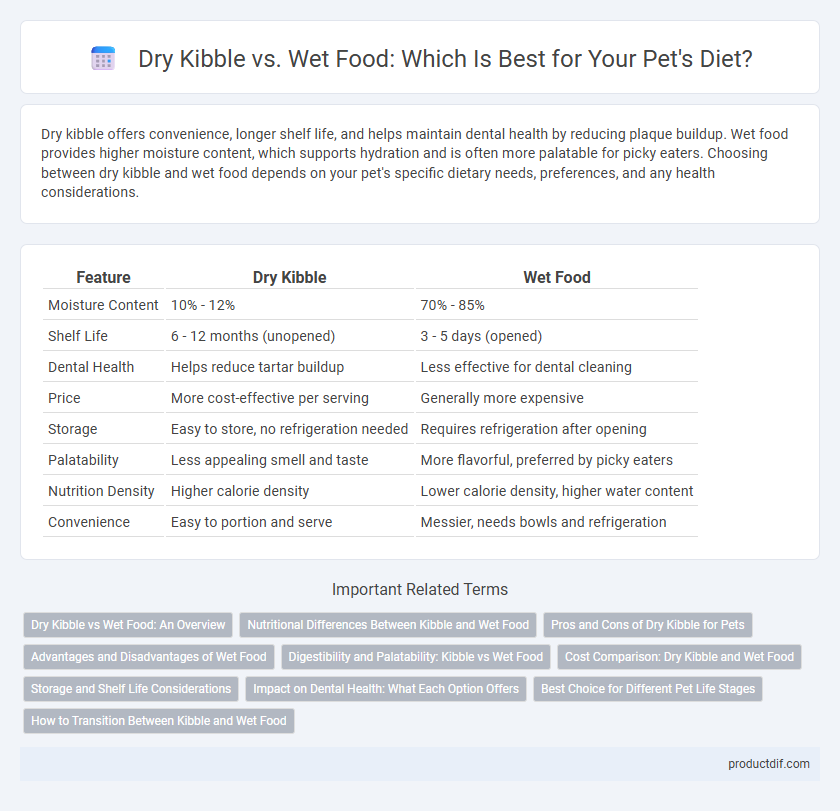Dry kibble offers convenience, longer shelf life, and helps maintain dental health by reducing plaque buildup. Wet food provides higher moisture content, which supports hydration and is often more palatable for picky eaters. Choosing between dry kibble and wet food depends on your pet's specific dietary needs, preferences, and any health considerations.
Table of Comparison
| Feature | Dry Kibble | Wet Food |
|---|---|---|
| Moisture Content | 10% - 12% | 70% - 85% |
| Shelf Life | 6 - 12 months (unopened) | 3 - 5 days (opened) |
| Dental Health | Helps reduce tartar buildup | Less effective for dental cleaning |
| Price | More cost-effective per serving | Generally more expensive |
| Storage | Easy to store, no refrigeration needed | Requires refrigeration after opening |
| Palatability | Less appealing smell and taste | More flavorful, preferred by picky eaters |
| Nutrition Density | Higher calorie density | Lower calorie density, higher water content |
| Convenience | Easy to portion and serve | Messier, needs bowls and refrigeration |
Dry Kibble vs Wet Food: An Overview
Dry kibble offers convenience, longer shelf life, and dental benefits by helping reduce plaque buildup, while wet food provides higher moisture content essential for hydration and often contains more protein and fat. Pet owners should consider factors like the pet's hydration needs, dental health, and preference when choosing between dry kibble and wet food. Nutritional adequacy and ingredient quality remain critical regardless of the food type selected for optimal pet health.
Nutritional Differences Between Kibble and Wet Food
Dry kibble typically contains higher concentrations of carbohydrates and lower moisture content, which can affect hydration levels in pets, while wet food offers increased water content and generally higher protein and fat percentages. Kibble's processing often involves heat extrusion that can reduce certain heat-sensitive nutrients, whereas wet food retains more natural vitamins and amino acids due to minimal processing. Choosing the right option depends on a pet's specific dietary requirements, including energy needs, hydration, and nutrient absorption.
Pros and Cons of Dry Kibble for Pets
Dry kibble offers benefits such as longer shelf life, convenience in storage, and cost-effectiveness, making it a popular choice for pet owners. It helps maintain dental health by reducing plaque buildup through its crunchy texture but may lack the hydration that wet food provides. However, dry kibble can sometimes be less palatable and nutrient-dense compared to wet options, potentially requiring pets to drink more water to stay properly hydrated.
Advantages and Disadvantages of Wet Food
Wet pet food offers higher moisture content, which supports hydration and is beneficial for pets with urinary or kidney issues. Its soft texture and strong aroma can enhance palatability, making it ideal for picky eaters or pets with dental problems. However, wet food typically has a shorter shelf life after opening, can be more expensive, and may contribute to dental plaque buildup if not supplemented with proper oral care.
Digestibility and Palatability: Kibble vs Wet Food
Dry kibble offers higher digestibility due to its concentrated nutrients and lower moisture content, promoting efficient nutrient absorption in pets. Wet food typically scores better in palatability, with its rich aroma and texture appealing to finicky eaters and encouraging hydration. Choosing between kibble and wet food depends on balancing ease of digestion with taste preferences to support optimal pet health.
Cost Comparison: Dry Kibble and Wet Food
Dry kibble generally costs less per serving compared to wet food, making it a more budget-friendly option for pet owners. Wet food tends to be pricier due to higher moisture content and packaging expenses, increasing the overall cost. Evaluating the price per calorie and portion size helps in determining the most cost-effective choice for pet nutrition.
Storage and Shelf Life Considerations
Dry kibble offers longer shelf life and easier storage due to its low moisture content, typically lasting six to twelve months when kept in a cool, dry place. Wet food, containing higher moisture, requires refrigeration after opening and usually has a shorter shelf life, generally around three to five days once opened. Proper storage in sealed containers for dry kibble and airtight containers for wet food helps maintain freshness and nutritional quality.
Impact on Dental Health: What Each Option Offers
Dry kibble promotes dental health by helping to reduce plaque and tartar buildup through its abrasive texture, which gently scrapes teeth during chewing. Wet food, while more palatable, lacks this mechanical cleaning effect and may contribute to faster accumulation of dental debris if not paired with proper oral hygiene. Regular dental care and veterinary check-ups are essential regardless of the chosen diet to maintain optimal oral health in pets.
Best Choice for Different Pet Life Stages
Dry kibble provides essential nutrients and dental benefits ideal for adult pets maintaining a healthy weight, while wet food offers higher moisture content crucial for puppies and senior pets with hydration needs. Puppies require nutrient-dense, easily digestible food for optimal growth, often found in wet formulas rich in protein and fats. Senior pets benefit from wet food's softness and added fluids to support joint health and kidney function, making food choice pivotal for each life stage.
How to Transition Between Kibble and Wet Food
Gradually mix increasing amounts of wet food with your pet's regular dry kibble over 7 to 10 days to help their digestive system adjust smoothly. Monitor your pet's reactions, such as appetite and stool consistency, to ensure they tolerate the transition well. Always provide fresh water alongside wet food to maintain proper hydration and support overall health.
Dry kibble vs Wet food Infographic

 productdif.com
productdif.com